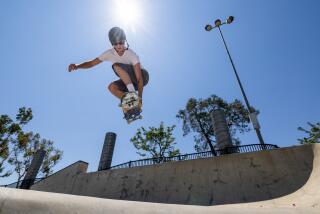Exercise Device Has an Edge That’s Not Just for Skiers
- Share via
The ski season will soon be here, so Skier’s Edge, a new indoor exercise machine that duplicates the lateral motion of downhill skiing, may pique the interest of California skiing enthusiasts. It was introduced in February after being tested the previous ski season by members of the U.S. men’s downhill team.
According to Jack Sprouse, U.S. men’s alpine trainer, the stationary training equipment helped his skiers maintain peak condition, and “strengthened the team’s agility, endurance and power while improving balance and rhythm.”
Manufactured by Scientific Sports Systems in Port of Redwood City in Northern California, Skier’s Edge weighs 40 pounds and is 61 inches long, 15 inches wide and 10 inches high. When not in use, it takes up less than 1 square foot of floor space.
Users wear athletic shoes, not skis, and Scientific Sports Systems representatives say that skiers of all levels and ages can use Skier’s Edge because it can be adjusted to 11 different tensions and can simulate different types of terrain--from easy cruising to bump runs.
“It’s the closest thing you can get to skiing in your living room,” said Barrie Houston, the company’s manager of marketing services.
In fact, Houston said, you don’t have to know how to ski to use Skier’s Edge. Because the machine’s motion is from side to side, it also is a good training and conditioning device for other sports that use lateral motion, such as tennis, racquetball, water skiing, football and soccer. She added that an intense aerobic workout on Skier’s Edge will burn about 200 calories in 15 minutes, according to research done for the company.
Skier’s Edge costs $495, plus $35 for shipping, and includes custom-made poles, a user’s manual, conditioning program and a training video. To operate the exerciser, you stand on the foot pads and apply pressure to the inside of the pads, transferring weight from foot to foot. You then move from side to side on the machine and plant the poles.
To order call the company’s 24-hour number at (800) 225-9669 or write: Scientific Sports Systems, 503 Seaport Court, Port of Redwood City, Calif. 94063.
Wheel Power
Another product often used in conditioning regimens by skiers, skaters and ice hockey players are Rollerblade skates, “in-line” roller skates that feature a row of wheels in a straight line instead of the side-by-side wheels of conventional skates.
The Rollerblade company is offering new models of skates this year, ranging in price from $90 to $175. Made for adults and children, they have a removable liner and upper boot, similar to a ski boot, come in several colors--with buckles or laces--and have polyurethane wheels. Junior sizes have only three wheels per skate; seniors, four.
Rollerblade skates are designed for outdoor use on pavement or for indoor roller rinks. The company, based in Eden Prairie, Minn., recommends that its skates not be used on wet surfaces, sand, gravel or dirt.
According to company representatives, Rollerblades were developed in 1980 by two Minnesota brothers for hockey players to use for off-season training. In researching the history of the “in-line” skate, they found that it was the original roller skate, probably developed in the Netherlands as early as the 1700s. It wasn’t until 1863 that an American inventor modified it, placing the wheels side by side, one set under the ball of the foot, the other under the heel.
For more information on Rollerblades, call (800) 232-ROLL. Los Angeles area stores carrying the skates include: California Sportsman in Sherman Oaks; Circle Skate and Surf and Rollerskate of America in Venice; Fitness Plus in Hollywood; Rip City Sports in Santa Monica; Golden Bear Athletics in Culver City, and Holiday House Ski Shop in Pasadena.
A Shoe Thing
Los Angeles sculptor Marguerite Elliot has found a different way for parents to preserve baby’s first shoes. Instead of the traditional bronzing method, Elliot uses a clear plastic resin coating that preserves the shoe’s colors and scuff marks. Even socks can be preserved in the shoes with the acrylic process.
She came up with the idea after putting some of the resin she uses in her artwork on her boyfriend’s high school basketball jersey. It became an interesting sculpture, she said, and when friends saw it, they asked if she could do the same thing to items they wanted to keep.
“My sister had just had twins and I was incredibly surprised by the high fashion of today’s children’s shoes,” Elliot said. “And using the socks adds a whole other dimension.”
So, Elliot founded Clear Memories, her own company that offers customized preserving of baby shoes. Prices range from $37 to $45, depending on the kind of base or display chosen by the customer. The children’s shoe departments of most Nordstrom stores have begun offering Clear Memories service to customers, or you can write to Clear Memories, 3456 Cody Road, Sherman Oaks 91403 for a free brochure and padded mailing envelope in which to send the shoes you wish to have coated with acrylic. Or you may call (818) 788-1656. Orders take three to four weeks.


